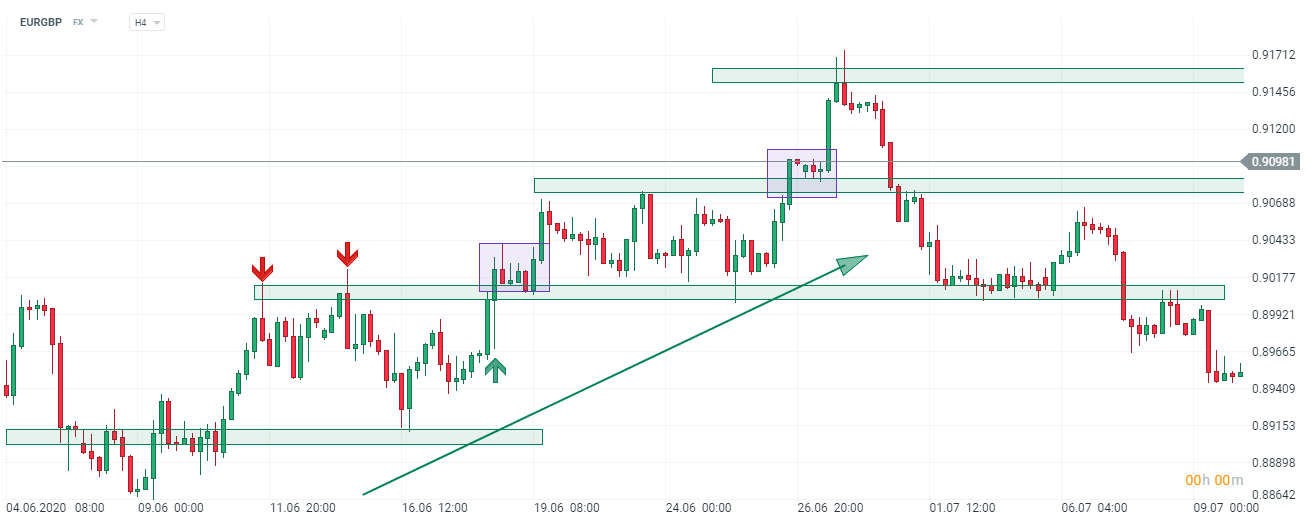Price Action - simple strategy, difficult to implement [Confirmation effect]
In this text, I would like to focus on a certain aspect that made Price Action a strategy that, despite its simplicity, is difficult to implement. In the Internet we will find a lot of information about it, and the crowd of its supporters has been growing successively for several years. Naked trading he has become extremely popular in the satiation of indicators and oscillators added in large numbers to the chart. Support and resistance, or the candle formations themselves gained thanks to their transparency. Without going too much into the details of the trading itself, according to Price Action, we will focus on a certain “trap” that has made trading by price response a bit complicated.
Why is Price Action difficult?
In every area of life (especially at work and education) some things come easily to some, while others are much more difficult. It is similar with the Price Action analysis. When drawing support and resistance on the charts, often in moments of consolidation of an emerging or already ongoing trend, we are looking for confirmation in the price, whether a given movement will continue, or whether the trend in the markets will reverse. There are as many trading methods as there are traders. Some will wait for a breakout, while others will see the price behavior in the sideways move into the position at “good prices”. Without deliberating on the behavior of quotes, every trader will approach Price Action with certain convictions. He looks for such confirmations in the consolidation or trend that will prove the correctness of his decisions. Cognitive discomfort occurs when our actions are not accurate. At this point, we often ignore conflicting signals and start selectively looking for those that make us believe that our decisions are right. This situation obviously occurs in many trading systems. Of these, however, the most signals and the most potential "trade mishaps" occur by the way naked trading.
Confirmation in practice
The confirmation effect in Price Action is a bit of its assumptions. During periods of price consolidation in support and resistance areas, we need to catch a further trend in price. Certainly, we will approach the quotes in which we play swing (position usually a few days), having a profitable trade on your account (and following the trend), and differently, when you want to make it. While in the position, it is much more difficult to look at the price behavior objectively. We are committed to further profit. We will be more willing to look for signals and messages that confirm our belief that we have made the right decision. Since we already have a profit, it means we were right.

Source: xNUMX XTB.
How to avoid the confirmation effect? First of all, a thorough analysis. I marked the support and resistance levels in the chart above. Only the moment when the quotations exceeds resistance (in an uptrend) can be called confirmation - purple places on the chart. Of course, there are several of them, not only the ones we have marked. On the other hand, we can call the test the moments when the price approaches the support / resistance and reacts (red arrows). Usually numerous are formed here candle formationswhich are extremely useful in the analysis. Also in these places, we can indicate the greatest chance of falling into the confirmation effect trap. We read the tests as places where it is worth adding to the position (in the upward trend of entries in longs). In practice, however, the places where the quotations are approaching certain levels, the only thing we should expect is the reaction of the price. Regardless of whether we have a position or we are just getting ready to trade.
Summation
Sometimes in books or trade literature we come across strategies that are simple at first glance. Unfortunately, there are few that can be applied just as easily in a chart. In my opinion, Price Action is a demanding strategy that must be “experienced” regardless of the interval used. By this I mean scrupulous observation of the price and searching and filtering signals. It is not a trading system that requires little intellectual input from us. For those who started and got lost a bit at Price Action, I would recommend that you focus on thoroughly learning how to analyze candles. They are well described in the book Nisona - Japanese candles, which we reviewed in this article. Price analysis is closely related to candle analysis skills. It's not enough to recognize trends. The key point is learning to "read proof" and how the price behaves in it.
Taking into account the purely psychological aspects related to the confirmation effect, it can be limited by approaching the markets very objectively. When concluding a transaction, or already in it, it is worth bearing in mind that you can be wrong and wrong. If everything speaks "yes" to entering a position, we should also look for potential negative signals. In addition, having a plan to play out a transaction is a basic issue that should be established before concluding it.
How to protect yourself from the confirmation effect? I think that the approach to trading and business will explain a lot in this matter. Treating quotes as an opportunity to earn, in which our beliefs are only beliefs, not a scenario that will surely come true. Price Action teaches objectivity in making decisions. Even with a profitable strategy, the thought that the situation may change in a moment is very psychological. We are constantly considering the market reversal scenario, thanks to which we are more sensitive to the signals coming from the price reaction.






















![Forex Club – Tax 9 – Settle tax on a foreign broker [Download the Application] Forex Club - Tax 9](https://forexclub.pl/wp-content/uploads/2024/02/Forex-Club-Podatek-9-184x120.jpg?v=1709046278)
![Trading View platform – solutions tailored to the needs of traders [Review] trading view review](https://forexclub.pl/wp-content/uploads/2024/03/trading-view-recenzja-184x120.jpg?v=1709558918)
![How to connect your FP Markets account to the Trading View platform [Guide] fp markets trading view](https://forexclub.pl/wp-content/uploads/2024/02/fp-markets-trading-view-184x120.jpg?v=1708677291)
![How to invest in ChatGPT and AI? Stocks and ETFs [Guide] how to invest in chatgpt and artificial intelligence](https://forexclub.pl/wp-content/uploads/2023/02/jak-inwestowac-w-chatgpt-i-sztuczna-inteligencje-184x120.jpg?v=1676364263)




![Izabela Górecka – “Success on the market depends not only on knowledge, but also on emotional stability” [Interview] Izabela Górecka - interview](https://forexclub.pl/wp-content/uploads/2024/04/Izabela-Gorecka-wywiad-184x120.jpg?v=1713870578)
![WeWork – the anatomy of the collapse of a company valued at $47 billion [WeWork, part II] wework bankruptcy story](https://forexclub.pl/wp-content/uploads/2024/04/wework-bankructwo-historia-184x120.jpg?v=1711729561)
![Adam Neumann – the man who screwed up Softbank [WeWork, part AND] adam neumann wework](https://forexclub.pl/wp-content/uploads/2024/04/adam-neumann-wework-184x120.jpg?v=1711728724)




![The most common mistakes of a beginner trader - Mr Yogi [VIDEO] Scalping - The most common mistakes of a beginner trader - VIDEO](https://forexclub.pl/wp-content/uploads/2024/03/Scalping-Najczestsze-bledy-poczatkujacego-tradera-VIDEO-184x120.jpg?v=1711601376)
![Learning patience: No position is also a position - Mr Yogi [VIDEO] Scalping - Learning patience - No position is also a position - VIDEO](https://forexclub.pl/wp-content/uploads/2024/03/Scalping-Nauka-cierpliwosci-Brak-pozycji-to-tez-pozycja-VIDEO-184x120.jpg?v=1710999249)
![When to exit a position and how to minimize losses - Mr Yogi [VIDEO] Scalping - When to exit a position and how to minimize losses - VIDEO](https://forexclub.pl/wp-content/uploads/2024/03/Scalping-Kiedy-wyjsc-z-pozycji-i-jak-minimalizowac-straty-VIDEO-184x120.jpg?v=1710336731)



![Price Action - simple strategy, difficult to implement [Confirmation effect] price action confirmation effect](https://forexclub.pl/wp-content/uploads/2020/07/price-action-efekt-potwierdzenia.jpg?v=1595078280)


![Predict and win! "Price Action Analysis: Retreats" [Contest] price action analysis retreats contest](https://forexclub.pl/wp-content/uploads/2021/03/analiza-price-action-odwroty-konkurs-300x200.png)
![Price Action - simple strategy, difficult to implement [Confirmation effect] precious metals silver gold](https://forexclub.pl/wp-content/uploads/2020/07/metale-szlachetne-srebro-zloto-102x65.jpg?v=1595421545)
![Price Action - simple strategy, difficult to implement [Confirmation effect] metatrader 4 on macos catalina](https://forexclub.pl/wp-content/uploads/2020/07/metatrader-4-na-macos-catalina-102x65.jpg?v=1595333898)










Leave a Response